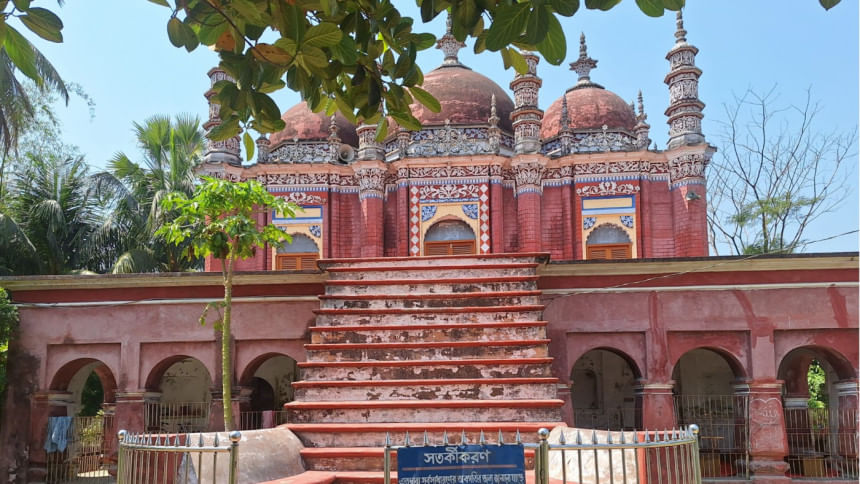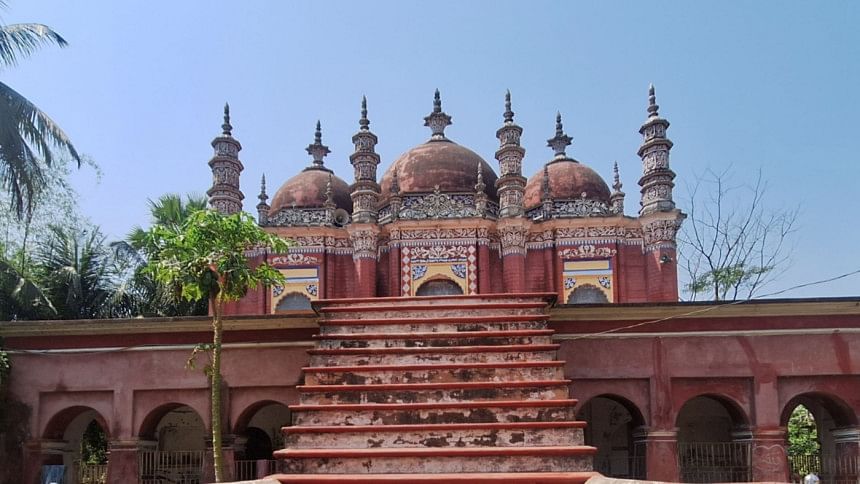Mia Bari Mosque: A forgotten legacy of Mughal architecture

Nestled in the quiet village of Uttar Karapur in Barishal Sadar upazila, the historic Mia Bari Mosque reflects the lasting influence of Mughal architecture in Bangladesh.
Despite its rich history and intricate craftsmanship, this architectural gem remains relatively unknown, its legacy overshadowed by poor accessibility and a lack of publicity.
Believed to have been built in the late 18th century, the mosque is attributed to Hayat Mahmud, a notable figure who rebelled against British rule.
According to records from the Department of Archaeology, Mahmud was exiled to Prince of Wales Island for 16 years before returning to build this magnificent structure.
The two-story mosque features six entrances on the ground floor and three on the upper level. Its three domes and eight towering minarets are classic representations of Mughal design, adorned with intricate carvings and elaborate ornamentation.
Mia Bari Mosque is a unique religious monument in Bangladesh, offering a rare two-tiered architectural layout.

Arif Ahmed, custodian of the Barishal Divisional Museum, emphasises its unique architectural significance. The main prayer hall spans 44.3 feet by 13.4 feet, with walls 3.4 feet thick, built using traditional terracotta bricks.
The mosque's facade features a mix of Mughal and local artistic styles. Its mihrab and arches are decorated with geometric patterns, floral designs, and terracotta details, highlighting the craftsmanship of that time.
Recognising its historical importance, the Department of Archaeology listed the mosque in its official gazette in 1990.
According to locals and descendants of the Mia Bari family, the mosque was originally built on 20 decimals of land and has undergone at least seven major renovations, the first during the tenure of Mahmud Zahid.
Today, the mosque remains an active place of worship, accommodating up to 150 worshipers.
Mizanur Rahman Babul, a prominent member of the Mia family and president of the mosque committee, suggests that the empty chambers on the lower floor may have once served as a travellers' inn or a temporary residence for religious preachers. A madrasa now operates within the mosque premises.
Over the years, Mia Bari Mosque has drawn visits from foreign diplomats, including the US ambassador and the Indian high commissioner.
Yet, despite its historical and architectural significance, the mosque remains largely overlooked due to its poor accessibility.
Expressing frustration, Historian Saiful Ahsan Bulbul said the lack of a paved road makes reaching the mosque difficult, limiting the influx of visitors, even though it stands close to Barishal city.
He said the only way to the historical mosque is muddy, making it inaccessible through cars.
He also said due to little to no promotion, very few actually know about this historical mosque.

 For all latest news, follow The Daily Star's Google News channel.
For all latest news, follow The Daily Star's Google News channel. 






Comments